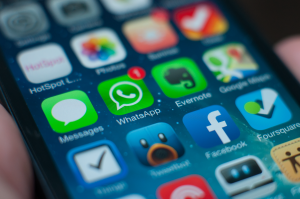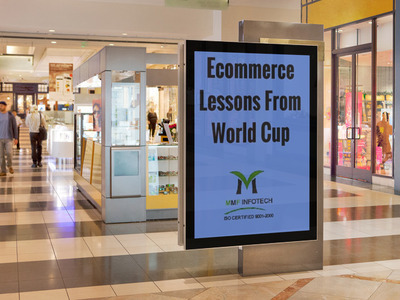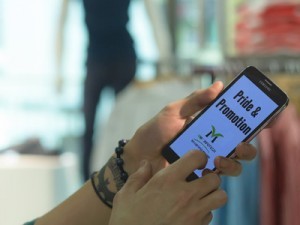Erik Qualman's Blog, page 547
April 29, 2015
Social Media is Fit to Print

With newspapers and print publications losing steam with younger audiences, many papers are turning to social media to stay relevant.
From posting news stories to tweeting breaking news events, many newspapers across the country are using social media to their advantage, looking to stay relevant in an ever-changing world of information delivery.
Here are just a few newspapers going social and how exactly they’re doing it:
Facebook and Twitter – The New News Standard
Everybody in the publication world is predicting that newspapers will disappear within the next decade.
Whether this is true or not, some of the most popular newspapers in the country are already putting a lot of effort in their social presence.
When it comes to Facebook, The New York Times already has well over 9 million likes. Coming in at a close second, The Wall Street Journal, The Los Angeles Times, and USA Today all have 2 to 3 million likes. This is compared to just five years ago when these publications had anywhere from 20,000 to 70,000 likes.
Likewise, The New York Times also has more than 16 million Twitter followers, which is up from 280,000 followers five years ago.
The Washington Post has also made strides in the Twitter arena by increasing its followers from just fewer than 5,000 to just over 4 million in the past five years.
Social Relevance
As the following article looks at, based on the numbers above, there is the question of should newspapers let Facebook host their content?
Well, whether it’s Facebook, Twitter, or any of the other social avenues, it all boils down to relevance.
Newspapers aren’t necessarily turning to social media to push content, but rather to become more relevant with new readers.
Sure, getting news stories across to the social public is part of the equation, but staying relevant with younger audiences is the main goal.
The world of print is changing and if newspapers want to stay in business, they have to adapt to the digital age. Social media is a stepping-stone in the process.
How Are Newspapers Making the Change?
The news world hasn’t abandoned print completely.
As long as there is still a readership that loves the feel of paper and the smell of ink, newspapers will stay in print.
However, there are a number of ways newspapers are making the transition to social media.
They include:
• Facebook Pages – Almost every major newspaper publication in the country now has a Facebook page. Through Facebook, newspapers are reaching more new followers and posting news stories that would otherwise be overlooked.
• Twitter Feeds – Newspapers are also using Twitter to share breaking news stories, poll readers, and even ask for the public’s help in reporting stories. Thanks to Twitter, the idea of social journalism is now a legitimate practice.
• Editorial Events – A growing number of newspapers are using Google+ Hangouts and Twitter to host editorial events. These events allow journalists and readers to discuss news events in a forum-style environment.
• Apps – Many newspapers are also creating apps that allow readers to stay connected from just about any mobile device. Newspaper apps are changing the way readers interact with the news.
From Facebook to Twitter and every social site in between, newspapers all across the country are truly taking on a social mindset.
Photo credit: Image courtesy of hywards at FreeDigitalPhotos.net
[image error]
April 28, 2015
Twitter Improves Ads By Acquiring TellApart, Selling Them Through Google’s DoubleClick

TechCrunch – To boost its commerce ads and sell more of them, Twitter announced some big moves as part of today’s earnings. It’s acquired commerce ads tech firm TellApart, which was formerly a big Facebook ad partner. Twitter will also now allow its ads to be bought through DoubleClick’s bid manager to help advertisers centralize their buying.
While today Twitter managed to exceed user growth estimates, it fell short on revenue, making these advertising developments more important than ever.
TwitApart
Interestingly, Twitter CEO Dick Costolo was an angel investor in TellApart. Costolo invested in TellApart’s $4.8 million Series A in 2010. Due to his financial interest in the deal, Costolo may have had to stay at ‘arm’s length’ to avoid unfairly influencing the deal.
Other investors that brought TellApart to a total of $17.8 million in funding include SV Angel, Harrison Metal, and Greylock Partners. Along with social ads for ecommerce retailers, TellApart also offers a way to place ads in other companies’ emails to potential customers.
Josh McFarland, co-founder and CEO of TellApart said “TellApart’s strengths in personalization, dynamic product ads, commerce data and with retail advertisers are strong complements to Twitter’s deep experience in mobile, understanding users and the app ecosystem.”
TellApart hit a $100 million revenue run rate in 2013. But the company also bet big on Facebook’s FBX ad exchange, which the social network stopped focusing on last year. That may have caused some turbulence that made the acquisition by Twitter a smart move. At Twitter, it plans to focus on aiding cross-device targeting and online/offline measurement so advertiser can reach users wherever they are, and ensuring that no matter where someone sees an ad or makes a purchase, Twitter can get credit.
DoubleTweet
Through the partnership with Google’s DoubleClick ad exchange, ad agencies and other buyers will be able to purchase inventory on websites around the web as well as Twitter Promoted Tweets from a single interface. Making Twitter ads easier to buy from one of the world’s most popular tools could help boost revenue. That’s something Twitter needs given it missed revenue estimates in today’s earnings.
Twitter is also hoping to strengthen advertiser confidence in the return on investment of its direct response commerce ads by working with DoubleClick to properly measure when clicks or actions on Twitter lead to a purchase or conversion. The program will roll out later this year so advertisers can attribute purchases to Twitter ads across platforms, regardless of whether the ad views or purchases happened on the web or mobile.
Twitter now has over 300 million users, including many highly engaged, influential and wealthy people. Still, its limited biographical data for targeting and relative size to top ad platforms like Google and Facebook has hindered its monetization.
Buying ads technology and partnering with top players could help Twitter better leverage its place in people’s lives to become a serious money-maker. It may take these new developments a few quarters to spin up, but they could boost the big bird’s bottom-line with time.
Article by Josh Constine for TechCrunch
Thumbnail courtesy of Shutterstock
[image error]
Should We or Shouldn’t We Automate Our Social Media?

You’ve finally gotten all the accounts going for your company’s social media. You have a great Facebook page, a cool Twitter handle, lots of Instagram followers and even a Google +, Pinterest and LinkedIn page. Now what?
You know that you need to keep all of this current; stagnating social media is a total turn off, but where’s the time?
Between managing your business, ordering supplies, client meetings, employee issues, you’re already spread thin enough. Do you have any options for your social media? Many people advocate automating your social media.
Let’s take a look at why or maybe why you shouldn’t, automate.
Pros of automating your social media:
• Probably this biggest reason to even be thinking about automation is as a time saver – And yes, automating your social media will save time. You will have more time to attend to the other things you need to do, social media related or not;
• You can set the time for posts to go live – Because of the short shelf life of social media, posts often get buried in a pretty quick time frame. Because you can schedule posts with automation, you don’t have to just to do at your personal convenience, which may be making a lot of your readers miss it. You can even extend the shelf life by sending out automated reminders and refreshers;
• You can reach a wider audience – The more active your social media is the more people you can reach. It doesn’t always mean you’ll keep them forever, but reaching them is the first step and with automation, this is a lot easier than without it.
Cons of automating your social media:
• You risk appearing fake – Automation just doesn’t have the same feel and tone as your own posts. You may have written something but when it goes live, you’re in a totally different place. You can’t always set the tone according to the platform, either, so you need to go a little generic. Maybe that will turn some readers off.
• You lose some engagement – If your posts are automatic, you’re not always there to give a personal reply. Again, this can be a turn off for those followers who seek a close relationship.
If you decided to go ahead and automate, you need the tools to do so.
As the following article looks at, here are 3 Great tools to automate your social media:
1. Hootsuite – You can manage multiple social media networks from one dashboard. Hootsuite allows you to track conversations and see what is going on all of your social media.
2. IFTTT – If This Then That is a great tool for your marketing efforts by automating a wide range of social media activities. With result-based automation, it works when a “trigger event” happens, then everything kicks in.
3. Buffer – This is a popular social media message scheduling system. You can share content and schedule when your posts go out with just one click, and then it hits the big names in your social media world, instead of doing them all separately.
As you decide what to do, remember, like most things in life, social media automation is probably best served with a balance of both automation and live, personal posts.
Use a good combination of live engagement, promotional posts and toss in a touch of humanity. You’ll figure it out and go with what your customers, followers and friends seem to like.
Best of luck and feel free to share what works (and doesn’t work) for you.
Photo credit: Image courtesy of stockimages at FreeDigitalPhotos.net
[image error]
Emoji are about to take over Instagram

Mashable - Instagram just made emoji posted within the app a lot more powerful. The company updated its iOS and Android apps Monday with the ability to add emoji hashtags to posts along with three brand-new filters.
Previously, Instagram’s hashtag feature did not support emoji, so comments or captions with the hashtag symbol and emoji were not searchable. Now, users can add emoji (or a string of emoji) to hashtags and posts that have been previously tagged with the characters will also show up in searches.
“Over the past few years, emoji have become part of a universal visual language,” the company wrote in a blog post. “With emoji hashtags, you can discover even more by adding them to your own photos and videos, searching them on the Explore page and tapping on them when you see them in captions.”
Monday’s update also added three new filters to Instagram’s toolkit: Reyes, Juno and Lark. Reyes is a more muted filter that “brings a dusty, vintage look to your moments,” according to Instagram, while Lark emphasizes blue and green tones and Juno ” tints cool tones green while making warm tones pop and whites glow for vibrant photos of people.”

Image from Instagram via Mashable
Instagram also plans to update the app with new filters more often, the company said, noting that two of the filters introduced its last big update, Ludwig and Crema, are among the app’s most popular. Those who are worried about their filter tray getting too crowded can choose which filters appear — and rearrange their order — in the “manage” menu at the end of the app’s filter list.
Article by Karissa Bell for Mashable
Thumbnail courtesy of Shutterstock
[image error]
5 Extreme Lessons From The World Cup That Can Upgrade Your Ecommerce Sales

Like the World Cup, an ecommerce is also a vast business platform to get increased profit. As the World Cup teams facilitate a protective game planning, ecommerce platform must raise its level from the consumer point of view through attractive & an informative product data entry on the site and get the opportunities for profitable sales. Here are some lessons which we should take from the World Cup:
1.) Do Advance Scouting:
The coaches in the world cup examine prior results and develop implementable strategies before beginning of each game.
Similarly, when it comes to ecommerce business, a retailer must have the capability to examine & understand the customer’s requirement when they land on your web page to buy any product.
2.) Set An Effective Line-Up Card:
Every individual player when playing a World Cup Match has a strategy in his mind to hold a position or to prevent a strike or attack the wing.
Similarly, when it comes to ecommerce, it is recommended that as an ecommerce business owner, you should instruct your sales and service representatives to increase your channel of communication by enhancing ecommerce product entry on the website. Additionally, utilize the strength of your service representatives and allocate them responsibility to provide a better shopping experience to consumers from your ecommerce site.
3.) Control The Ball:
When playing World Cup Match, every player has to adapt the game strategies & planning’s of their rival team.
Likewise, as an ecommerce owner, you must follow the master plan that can engage your customers with different ecommerce organizations through the different channels. With this, the numerous online technologies like web service, audio video communications and social media are the best source to provide the customer queries any time.
4.) Join the Global Party:
When FIFA world was ongoing, there were 672 million tweets and about 350 million Facebook users while the tournament. Due to this, social media platforms have boosted the brands of the FIFA World Cup and with this every nation had celebrated the successes of the teams.
Likewise, as an ecommerce retailer, you must emphasize on social media channels to enhance your product brands with seamless product uploading services and implement the engaging strategies to grab attention of customers.
5.) Pride & Promotion:
In every four years when FIFA world cup about to held, the nations from worldwide are given a seamless opportunity to win for their country to show pride & honor. Moreover, as the date of tournament come closer the fever of World Cup can be felt in the audience completely at various parties, get-togethers as well as in various advertising campaigns.
Relevantly, when we talk about e-commerce business, it is required to do the promotion of their products through various advertising campaigning and by creating their product image a social buzz among the consumers thereby expand their products globally.
Conclusion:
The conclusion is that try to engage your customer proactively as well as in an elegant way. Follow the above steps and implement the mindful strategies to get your customer on your site for long-term & to boost your e-commerce business.
[image error]
April 27, 2015
Social Media Isn’t All Wet

Natural disasters can strike at any time in a wide variety of locations across the world.
While there’s no way to avoid a natural disaster, there are ways to be better prepared for when disaster strikes.
Some natural disasters, such as mild hurricanes, might just have you stay in your home and not drive or go outside.
Other more serious disasters might force you out of your home and to evacuate your city.
Whatever the disaster is, though, it’s important to know in advance what is happening so you can prepare yourself, your family and your home.
The Social Way to Communicate
Social media is becoming one of the biggest and best ways we communicate.
Since important weather information can be relayed to millions of people in a matter of seconds, many people are turning to social media to stay up to date with important weather conditions, including floods and hurricanes.
Two of the best weather channels that update regularly on social media are the National Weather Service and AccuWeather.com.
By Tweeting updates and posting current weather conditions on Facebook, word of a natural disaster can spread much faster than if you were to rely on the television.
Also, phone lines tend to go down when lines are overwhelmed with people calling in, making social media the best option to turn to when a flood or hurricane is approaching.
Repairing flood damage can be costly.
The size of the project, severity of the damage and the area you live in will all affect the price you will pay. Minimal damages might cost only a few hundred dollars, but severe flooding could cost the victim tens of thousands of dollars in repairs.
The article “Why federal contractors need to plan more for flood risks now” discusses a new law that alters floodplain criteria.
Both federal building and road projects will be affected by the new law put in place by President Obama.
Social media and Floods
If you live in an area that is prone to floods, hurricanes or any other natural disaster, it’s more important than ever to be tuned into social media.
You can set up weather alerts on your smartphone, follow weather stations on Twitter and turn to Facebook to receive up-to-date alerts on what’s going on in your area.
Weather apps you’ll want to look into include the Weather Channel App, NOAA Weather Radio HD, Storm Shield Radio Weather App and WeatherCaster.
Once you’ve been alerted, do your part by helping spread the word across all of your own social media profiles.
Facebook family and friends, for example, might not yet be aware of a storm warning. You can make a post alerting others of the news so everyone can be as prepared as possible. Continue following the apps and checking your social media profiles throughout the storm warning.
Hopefully it will subside, but if not, you’ll be able to evacuate or better prepare yourself in the event of a large natural storm.
Photo credit: Image courtesy of dan at FreeDigitalPhotos.net
[image error]
Private Messaging Apps – The Future of Mobile Marketing

With more and more private messaging apps becoming available, consumers are loosening their ties to websites. In fact, according to We Are Social’s Digital, Social and Mobile in 2015 report, four of the world’s six largest global social platforms are messaging apps. Facebook still leads with 1.36 billion monthly active users, but QQ comes in at 829 million, WhatsApp at 700 million, Facebook Messenger -500 million and WeChat at 468 million, ranking ahead of any other social network.
Why the sudden shift?
They are private and personal
There are a few reasons for this significant shift and privacy is a big one. Social messaging apps are regarded as private forms of communication. And unlike public social platforms like Facebook, Twitter and YouTube, messaging apps are not focused on exposure and influence – the focus is more on one-to-one interaction, rather than one-to-many. Users can also personalise these apps, which makes it a more unique experience. And it is this more intimate and personal experience that users enjoy.
They are multi-functional

Another reason for the shift is the multi-faceted nature of the apps. Private messaging apps act as multi-functional alternatives to traditional SMS text messaging, and include a myriad of features that vary by app. Users, can share photos, videos and other media files with their contacts, and some apps even offer games users can play and animated stickers to share with their friends. On China based messaging app, Wechat, users can do things like pay phone bills, order a taxi, buy flight tickets, manage finances or purchase products directly on the platform.
They are convenient and easy to use
Furthermore, there are increasingly less reasons for people to go online. When a person can access and do almost anything from one place, why would they do it any other way? Private messaging apps are a convenient and easy way to connect and get things done in the simplest way possible. So it’s a wise decision for marketers to start thinking smaller and targeting consumers where they spend most of their time.
Who else is doing it?
 Snapchat
Snapchat
Snapchat have caught on quicker than other private messaging apps and is possibly the best platform to target. They have been experimenting with ads and have also launched a new ‘Discovery’ feature that allows content-creators to publish ad-supported videos on the app.
Celebrities
All kinds of celebrities, including Pop stars, are using private messaging apps to send announcements; offer sneak peeks of upcoming content; and spark conversation with fans. Madonna recently launched her latest music video through Snapchat’s new Discovery feature, which surprised everybody and attracted a frenzy of media attention.
HBO
 Last November, the popular HBO show, Girls uploaded a sneak preview of an upcoming episode on Snapchat. Only fans that added the show as a contact could see it, which is a good example of how brands can use private messaging apps as a loyalty rewards tool.
Last November, the popular HBO show, Girls uploaded a sneak preview of an upcoming episode on Snapchat. Only fans that added the show as a contact could see it, which is a good example of how brands can use private messaging apps as a loyalty rewards tool.
Toyota
It is possible to determine which apps are most popular in any given country. In Spain it’s Whatsapp, and Toyota took advantage of this by launching a flirting competition close to Valentine’s day. Whatsapp users where then invited to send a private message to Toyota with their best cheesy chat-up lines, pictures and videos. Toyota was successful in receiving 1,100 messages in the first five days, due to the way they played up to how Whatsapp is generally used.
The future of mobile marketing
Although it may not be for every brand, private messaging provides incredible opportunities for most. Not only does it allow you to reach a wider audience and grant you the ability to segment it, it also allows you to build intimacy with consumers and personalise your marketing and customer experience.These days it’s even harder to reach out to consumers. Interruption-based ads merely appear as background noise to regular users. So, with the arrival of even more niche private messaging apps comes a break that brands should grab with both hands.
Private messaging could definitely become the most efficient way to reach and engage with consumers and is quite certainly the future of mobile marketing.
[image error]
April 24, 2015
Microsoft And Google Battle Once Again For Title Of Second Most Valuable Tech Company

TechCrunch – After reporting earnings yesterday, Google and Microsoft are once again locked in their long-running battle for second. Apple, the most valuable technology company, is also the most valuable company in the world, with Google and Microsoft rounding off the top three.
Google, up 3.56 percent as of the time of writing, is currently worth $385.59 billion. Microsoft, up 9.47 percent, is worth a similar $389.24 billion. Earlier, the companies managed a $388 billion moment of parity. Their shares are still gyrating, so we could see the companies pass the baton back and forth before the day’s regular hours come to a close.
There is rich history of watching Apple, Microsoft and Google fight for the top three. Let’s rewind:
TechCrunch, May 26, 2010: “Boom, Indeed: Apple Passes Microsoft In Market Cap.”
Worth just over $227 billion apiece, Apple passed Microsoft’s value in 2010. Apple has since more than tripled in value. Microsoft is up a more modest 71 percent.
TechCrunch, February 14, 2011: “Apple Now The Most Valuable Tech Company By $100 Billion; Google Closing In On Microsoft.”
Apple was now worth $330 billion and Microsoft $228 billion. Put another way, Apple’s value grew by $100 billion, or just under a third in less than a year. Microsoft was all but unch.
TechCrunch, October 17, 2014: “Google And Microsoft Battle For Market Cap Supremacy.“
In the latter half of 2014, both Google and Microsoft managed to be worth $351 billion and $352 billion respectively.
Then, Microsoft had a bit of a rough patch, and for some time was worth a margin less. Following the most recent set of earnings reports, Google didn’t pick up as much new oxygen as Microsoft, and now they are once again trading places.
Neither company is anywhere close to challenging Apple’s market cap, making it a race for silver for now.
Article by Alex Wilhelm for TechCrunch
Thumbnail courtesy of Shutterstock
[image error]
FMs Bringing Their Social Game

Facilities managers are essential to the operation of a business.
Their role is to ensure the working environment is suitable for employees, including both the exterior of the building and repairs and renovations on the inside of the building.
Facilities managers might not think that social media plays an important role in their job, but as the platforms continue to grow, it’s becoming a necessity.
Facilities managers and social networking
A big role of facilities managers is to keep the office and the environment green, or environmentally friendly. There’s no easier way to get employees to pitch in with the plan than by turning to social media.
Most likely, the company the facilities manager works for has a Facebook page, a LinkedIn profile, a Twitter account and a Google Plus page.
Facilities managers can find out which social media pages the company’s employees are using and post their requests on that channel.
In addition to social media allowing facilities managers to stay connected to employees of the company they work for, social media also allows them to stay connected to other facilities managers.
Among the sites to zero in on:
Facebook is currently the largest social media platform with more than 1 billion users worldwide. Facilities managers can join groups such as the International Facility Management Association and stay connected to other facilities managers around the globe.
LinkedIn is the social site for professional networking. If you are a facilities manager and are possibly looking to switch companies, LinkedIn can be a useful tool to help you find a job. You can post your resume, connect with other facilities managers and network with companies you hope to work for.
Google Plus is similar to Facebook but not quite as large. Ways facilities managers can use Google Plus include joining “Circles” to connect with both other facilities managers and employees of the company that they work for.
Twitter can be used by facilities managers to stay connected with employees, stay up-to-date on company information and connect with other facilities managers across the world.
The article “12 Little known things FMs can do on Facebook, LinkedIn and Twitter” discusses tools that make using social media for FMs easier.
Tips include adding a “Contact us” button on your Facebook business page, embedding media profiles on your LinkedIn page, creating a resume on LinkedIn and creating a photo collage on Twitter.
Many FMs who are using social media don’t know all of the benefits that it has. By learning the ins and outs, FMs can use social media to their advantages.
Social media should be used regularly by facilities managers in order to stay in contact easier with employees of their company.
They can regularly post updates on social media regarding anything going on with the grounds of the company, any road closures or any remodeling projects taking place.
Hopefully, social media will allow for important, up-to-date information to be easily relayed to employees.
By using social media and taking advantage of features to make it easier, FMs jobs will be better managed and easier to organize.
Photo credit: Image courtesy of Shutterstock
[image error]
Comcast, Time Warner Cable nix $45B merger deal

USA TODAY – Comcast Corp. said Friday that it’s ending its $45.2 billion merger agreement with Time Warner Cable, scrapping a giant deal that ran into stiff opposition from consumers and a likely veto from federal regulators.
Comcast is also calling off a related transaction withCharter Communications.
“Today, we move on,” Comcast CEO Brian Roberts said. “Of course, we would have liked to bring our great products to new cities, but we structured this deal so that if the government didn’t agree, we could walk away.”
In a statement, Time Warner Cable said the decision was “mutual.” The agreement included no breakup fee if the merger wasn’t approved or either side abandoned the effort.
“We have always believed that Time Warner Cable is a one-of-a-kind asset,” said TWC CEO Robert Marcus, in a statement. “We are strong and getting stronger. Throughout this process, we’ve been laser focused on executing our operating plan and investing in our plant, products and people to deliver great experiences to our customers.”
If the deal had been completed, Comcast planned to move 3.9 million of its TV customers to Charter Communications. Charter also recently agreed to buy Bright House Networks, which has had distribution and negotiating deals with Time Warner Cable for years. Given today’s development, the Bright House deal may not proceed given that Time Warner Cable has the right to block it.
In February, Philadelphia-based Comcast agreed to pay $45.2 billion to buy Time Warner Cable, a move that would consolidate the nation’s two largest cable companies. The deal would have given Comcast a quick means to gain customers in key markets, including New York and Los Angeles, and broaden its reach nationally. If Comcast had completed the deal, the post-merger company would have gained access to nearly half of the Internet market nationwide and heightened its bargaining leverage against content creators and cable networks.
As soon as the bid was announced, consumers and advocacy groups launched massive campaigns online and in Washington, D.C., to urge regulators to nix a proposal that they claim would give one company too much clout in pay-TV and Internet services.
Time Warner Cable shares fell 0.51% to $148.00. Comcast rose 1.3% to $60.00.
“This is a major victory for consumers who stood up against a media Goliath and won, and a major victory for everyone who wants a fair and competitive marketplace,” Marta Tellado, CEO of Consumer Reports, said in a statement. “Comcast never was able to make a convincing case for why the merger would benefit anyone other than Comcast.”
Analysts and traders have anticipated the deal termination for some time, given reports that regulators were concerned about its ramifications. Comcast on Wednesday held a series of meetings with the Justice Department and the Federal Communications Commission, the government entities that were reviewing the deal.
Bloomberg News first reported last week that the Justice Department was leaning against the merger. Officials at the FCC have also have recommended issuing a “hearing designation order” for the deal, which would let an administrative judge decide on its merits. That is often fatal for such transactions.
With the post-merger Comcast controlling a large chunk of the broadband market, it would have been in position to impose its will on new video streaming services and possibly insert anti-competitive measures in the fledgling market, analysts say. For example, Comcast could have insisted on a cable network forgoing an app on other smart-TV devices, such as Apple TV or Sling TV, if it wanted its content distributed to Comcast customers.
“The main issue is the development of new video services and new video companies,” says John Bergmayer, an attorney at consumer technology advocacy group Public Knowledge, which has argued against the deal. “We are just seeing (this video) market starting to evolve. You get Comcast and (TWC) together, they’re going to be able to fight that change effectively.”
In the wake of those developments, a number of Wall Street analysts proclaimed the deal dead.
“Comcast and Time Warner Cable’s decision to end Comcast’s proposed acquisition of Time Warner Cable is in the best interests of consumers,” FCC Chairman Tom Wheeler said in a statement. “The proposed transaction would have created a company with the most broadband and the video subscribers in the nation alongside the ownership of significant programming interests.”
With more streaming video options, like Netflix, proliferating and cable networks willing to experiment with new ways to stream directly to consumers, the proposed merger “would have posed an unacceptable risk to competition and innovation,” he said.
In a statement, the Department of Justice said it informed the companies that it had “significant concerns that the merger would make Comcast an unavoidable gatekeeper for Internet-based services that rely on a broadband connection to reach consumers.”
“The companies’ decision to abandon this deal is the best outcome for American consumers,” said Attorney General Eric Holder. “This is a victory not only for the Department of Justice, but also for providers of content and streaming services who work to bring innovative products to consumers across America and around the world.”
Wall Street is now looking for Comcast to return more cash to investors in the form of stock buybacks, which reduce the number of shares outstanding and boost the companies’ earnings per share. In an interview with CNBC this morning Comcast’s CEO Roberts said “there’s no looking back,” and acknowledged that the failed merger deal does, in fact, “open up room for more buybacks.”
Analysts also will begin to speculate what happens to TWC, which has about 11.4 million pay-TV subscribers and is still considered a takeover target. As Marcus points out, the New York-based company has tightened its operations to get ready for integration with Comcast. And at least one party, legendary cable executive John Malone, already has expressed interest in TWC.
Charter Communications, which is controlled by Malone’s Liberty Media Corp., bid about $37 billion for TWC last year prior to Comcast’s higher bid. But in November, Malone replied “Hell, yes” when he was asked at an investor conference if he would consider buying TWC if Comcast’s bid was not approved.
With so many business and technological challenges ahead, an industry consolidation of smaller cable companies — such as Cox Communications, Cablevision Systems Corp., Charter and Bright House — may be inevitable, analysts say.
Article by Roger Yu for USA TODAY
Thumbnail from Shutterstock
[image error]









